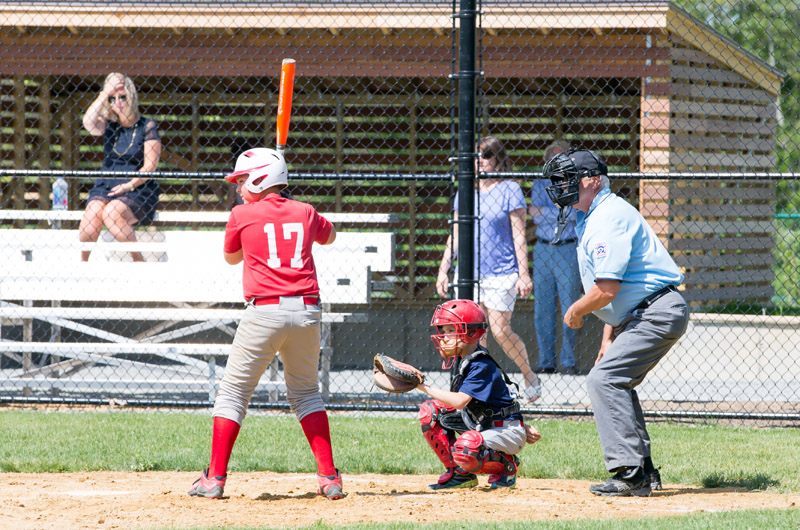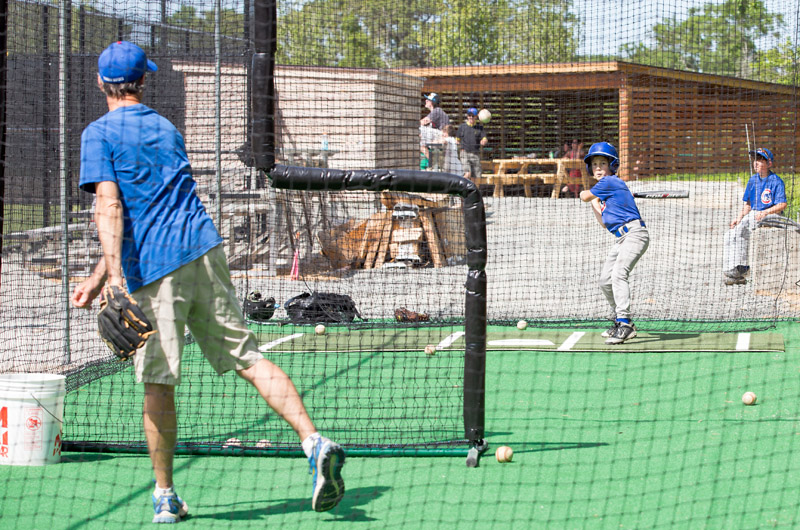The Red Sox and the Cardinals were facing off last Saturday afternoon, but not at Fenway Park or Busch Stadium. Instead, both teams were going head to head in the lush grass and freshly watered dirt of Little League’s new Penn Field in Oak Bluffs.
The field is the culmination of nearly eight years of work and hundreds of thousands of dollars. It officially opens this Saturday for the Little League championship games when the journey from debris-strewn lot to baseball diamond finally comes to an end.

For the past 50 years, Martha’s Vineyard Little League had played at the Veira Park baseball field near the center of Oak Bluffs. The field worked for what it was, but limited the league’s options, especially for travel teams.
“We’d go off-Island and see these beautiful fields,” said Little League president Rick Mello. “State of the art, just showcase stadiums.”
Martha’s Vineyard had no showcase stadium.
If the league wanted teams to come to the Island they had to provide two playing fields. Without a second field, teams always had to travel off-Island to play mainland teams at great expense. The limited space of only one diamond also prevented Vineyard teams from having the adequate training and practice time they needed to perform at their best. So in 2007, the Martha’s Vineyard Little League board decided that the best course of action would be to start constructing a new field next to the existing one in Veira Park.
The board was aided in this effort by the Oak Bluffs community preservation committee, which allocated $200,000 to begin building the field. But neighborhood pushback in the area around Veira Park soon complicated the issue. Emotions swirled and lawsuits surfaced. Ultimately, the proposal was shelved in favor of a new location: a vacant car dump the town had purchased in 2007.
Referred to as the “Leonardo Property,” the new site was located behind the Oak Bluffs dump and littered with old auto parts, broken glass and other random bits of garbage. Turning it into a baseball diamond for children was not going to be cheap or simple. To begin with, the lot was completely barren with no topsoil or any other foundation for planting. Just the expenses involved in clearing the land were almost prohibitive. In this environment, the project stalled once more.
By 2011, the lot was being used as a car dump again, and the $200,000 in CPA funding the project had been awarded back in 2008 was about to expire. The Little League board decided to bring in Phil Regan, a principal with Hutker Architects, who had worked on the Martha’s Vineyard Sharks stadium at the high school.
The first issue was clearing the land. This alone would require $50,000 of the project’s $200,000 CPA funding. But even after the shards of glass and old car parts were removed, there was still significant work to be done before the actual field could be put in. The property had no direct access road, and the ground needed to be replaced to allow grass to grow and to make sure it wasn’t still filled with overlooked bits of glass. And all of this needed to be done within the tight budget and regulatory constrains of the project’s funding.
“I needed someone who would do a good job and who could help us,” Mr. Regan said. “Maybe even do it for free.”
John Keene was contracted to remove sand, import topsoil and clean the area. He even built an access to the property at no cost. But because Mr. Keene had been contracted outside of the competitive bid process (he is an old high school baseball friend of Mr. Regan), none of the CPA funding could be used to pay him for his services.
The league then had to raise around $120,000 in outside donations to pay Mr. Keene for his work while simultaneously continuing the project. Of the original CPA funds, only $130,000 remained, all of which had to be spent using the competitive bidding process, a further hindrance to progress.
“You’re forced to accept the lowest bid, and usually it’s the lowest bid for a reason,” said Mr. Regan. “I felt like we could get lots of things done at enormous discounts instead going through people we previously knew. But once it goes out to competitive bid, the local guys all say, ‘I’m too busy to file all that paper work to do that.’”
Consequently, the project either had to rely on publicly bid contracts to finish the field or free labor. Anything else would have to be funded through private donations. There was little funding to spare.
“We’re Little League. We don’t make any money,” said Mr. Mello. “We’d do a little, then have to hit the pause button.”
Slowly, the project began to creep along and pick up some steam. But the CPA funds eventually ran out, and while many on the Island were happy to make in-kind contributions of labor to the field, this wasn’t enough to get the job done.
But in 2014, two new sources of funding entered the picture. One was a recent rule change to the Community Preservation Act that allowed regional organizations (such as Little League) to solicit funds from surrounding towns, allowing Little League to ask for $50,000 each from Tisbury, Oak Bluffs, West Tisbury and Edgartown. Edgartown and Oak Bluffs gave the full $50,000, with West Tisbury contributing $25,000 and Tisbury allocating $10,000. It wasn’t everything Little League had asked for, but it was an invaluable boost.
Then in January of 2015, MVYouth, a new philanthropy group created to help Island youth, awarded Little League $177,810 to finish the project.
Work on the field intensified after the harsh winter and the league was faced with a dilemma: wait until next season when everything could be perfect or open the fields in time for the championship games on Saturday. The decision? Play ball!
On Saturday, June 20, the Penn Field project will finally receive its moment in the sun, hosting the AAA Minor league championship game at 11 a.m., with awards and closing ceremonies after that game, and then the Major League championship game starting at approximately 2 p.m.
Mr. Regan said that the games will also be an opportunity to see what else needs to be accomplished. But mostly it will be a moment to stand back and embrace a vision first imagined in the twilight years of the Bush administration.
Last Saturday’s game was one of the first times the field actually saw action, a warm up of sorts in advance of the championships. With young players kicking at the mound and parents chatting in the glistening stands, the afternoon was a fairly typical day in the life of Little League.
“I like it,” said Sylvia Metell as she glanced around at the diamond, there to watch her grandson Owen play for the Red Sox. “Could use some more parking, but it’s nice.”







Comments (1)
Comments
Comment policy »